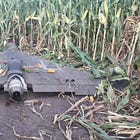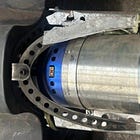Russia Informally Unveils Multiple Strike Munitions During Putin Visit To Perm Factory
🇷🇺 🇺🇦 Analysis
Russian President Vladimir Putin’s visit to the Motovilikha military industrial facility in Perm, which is located in the eponymous Russian province west of the Ural Mountains, has resulted in the informal unveiling of several unseen strike munitions.
The exhibition was held in one of the newly constructed buildings at the Motovilikha facility.


While artillery and air defence systems constituted the bulk of the equipment on display, a diverse array of strike munitions amounted to some of the most notable inclusions.





A Possible Guided Glide Bomb


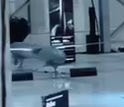

One of the strike munitions on display features large—possibly fixed—wings, two suspension lugs, and a cylindrical airframe. Available imagery does not offer any indication of the presence of a propulsion system. Supposing that this is an unpowered design, this is likely to be an extended-range guided glide bomb.
A Possible Air-Launched Cruise Missile


Another strike munition on display is likely to be either an air-launched cruise missile or an air-launched guided glide bomb. While available imagery does not offer any indication of the presence of a propulsion system, it is worth noting that an apparent turbojet engine was on display right in front of this strike munition. The Russian air force is in desperate need of a medium-range standoff strike munition, whether powered or unpowered, that offers a greater range than the UMPK and UMPB guided glide bombs while equipped with a heavier warhead than the likes of the Shahed-136/Geran-2/Garpiya propeller-driven fixed-wing strike drone, which can be equipped with a 90-kilogram warhead in a reduced-range configuration.
A Surface-Launched Banderol Cruise Missile


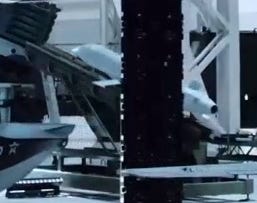

The Perm display included what may be a surface-launched version of what Ukrainian military intelligence refers to as the S8000 Banderol cruise missile. The Banderol was previously understood to be an air-launched cruise missile associated with the Russian Kronstadt Orion/Inokhodets, which is a fixed-wing, so-called medium altitude, long-endurance (MALE) ISR drone powered by a piston engine. There is no ambiguity that this specimen is a powered cruise missile. This airframe, including the beaked nose section and distinct control surfaces, is consistent with the digital model of the S8000 Banderol released by Ukrainian military intelligence earlier this year.
The apparent ground-launched Banderol is notably equipped with two suspension lugs, which may reflect a production configuration that can be either launched from the ground—with the aid of a solid propellant rocket booster—or from the air. It is important to note that the Kronstadt Orion/Inokhodets ISR drone is operated by the Russian Army, not the Russian Air Force. The Russian Army also operates Russia’s Shahed-136/Geran-2/Garpiya propeller-driven fixed-wing strike drones. According to Ukrainian military intelligence, the air-launched version of the Banderol can travel up to 500 km at a cruise speed of 500 km/h while equipped with a ~100 kg warhead. Supposing that this information is accurate, the air-launched version of the Banderol cruise missile would appear to offer broadly comparable performance to Russia’s recently unveiled (ground-launched) turbojet-powered Geran-3. While a ground-launched Banderol will have a lower nominal maximum range than its air-launched counterpart, it will compete with the Geran-3 for funding and missions against many of the targets attacked by the Russian Army across Ukraine, which typically take place a distance of less than 500 kilometers from the frontlines/international border.
An Uncrewed Surface Vessel And An ISR Drone To Forward-Launch Shorter-Range Strike Munitions
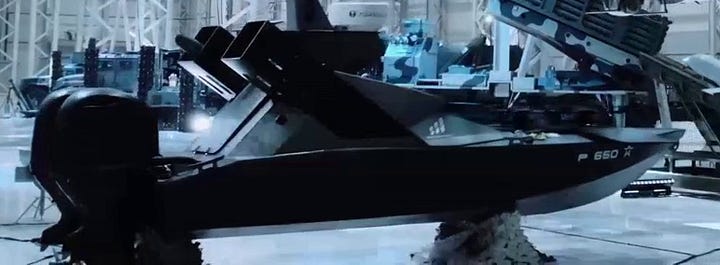

Other strike systems on display included an uncrewed surface vehicle (USV) equipped with two canister-launched munitions of unknown type and a fixed-wing ISR drone that was equipped with both an unknown cylindrical payload on its wing and what appears to be a multirotor drone. Nominally reusable aerial and/or naval platforms, whether crewed or uncrewed, can be used to forward-launch lower-cost short-range strike munitions, thereby moderating the number of more expensive longer-range strike munitions that the Russian military requires.
A Smaller Propeller-Driven Fixed-Wing Strike Drone And A Turbojet-Powered Version Thereof
Several propeller-driven fixed-wing strike drones were part of the display. While these somewhat resemble the Shahed-136/Geran-2/Garpiya, these are, in fact, much smaller strike drone designs with important differences.



The above propeller-driven fixed-wing strike drone design shares the cropped delta wing of the Iranian-origin Shahed-136/Geran-2/Garpiya and its distinctive wing stabilizers, but is much smaller and features a different piston engine design.

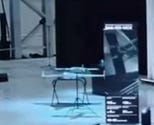
The above images reveal the existence of what may be a turbojet-powered version of the aforementioned propeller-driven fixed-wing strike drone design, one that is also of similar appearance to the Shahed-136/Geran-2/Garpiya but is much smaller. The turbojet engine in question is likely to be a commercially sourced design that is typically used on hobby aircraft. A small and short-range but quite fast turbojet-powered strike munition like this can evade Ukrainian multirotor and fixed-wing interceptor drones to attack battlefield targets.
Uncertainties notwithstanding, Russia recently unveiled several new and quite interesting strike munitions designs at the exhibition in Perm. As with so many aspects of Russian military industrial activity since February 2022, any serious analysis must ask whether the underlying research and development efforts are individually and collectively too little, too late.


